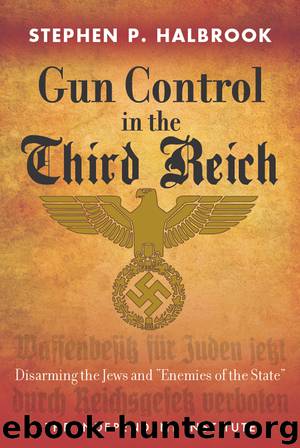Gun Control in the Third Reich by Stephen P. Halbrook

Author:Stephen P. Halbrook
Language: eng
Format: epub, mobi
Publisher: Independent Institute
It is noteworthy that, on the face of the law, Jews were not named as automatically disqualified. Gypsies were the only ethnic group that did not qualify. It might be that the Nazi leadership did not feel confident of the support of enough Germans to disarm Jews at this time. Many Jewish men had fought in the Great War and had retained their sidearms.37 This reluctance would change later that year.
For officially supplied firearms, a license to acquire or carry firearms was not required of members of the armed forces, the police, “members of the SS reserve groups, and the SS Totenkopfverbände [Skull and Crossbones units],”38 as well as the following: “lower echelon leaders of the National Socialist German Workers’ Party, from local group leaders upwards; of the SA, the SS, and the National Socialist Motor Corps from Sturmführer upwards as well as the Hitlerjugend from Bannführer upwards, to whom the Deputy of the Führer or an office designated by him, granted the right to carry firearms.”39
Possession of any kind of weapon could be prohibited where “in individual cases a person who has acted in an inimical manner toward the state, or it is to be feared that he will endanger the public security.”40 Such cases could include any opponent of Nazism or simply any disfavored person. No compensation would be paid for the confiscation.
It was forbidden to manufacture or possess “firearms that are adapted for folding or telescoping, shortening, or rapid disassembly beyond the generally usual extent for hunting and sporting purposes.” Firearms with silencers or spotlights were prohibited. Also, .22-caliber rimfire cartridges with hollow-point bullets were outlawed.41
The penalty for willfully or negligently violating the provisions of the law related to the carrying of a firearm was up to three years imprisonment and a fine.42 A fine and indeterminate imprisonment was imposed on anyone who violated other provisions of the law or implementing regulations.43
The primary Hitler–Frick innovations to the 1928 Weimar law were the exclusion of Jews from firearms businesses and the extension of the exceptions to the requirements for licenses to obtain and to carry firearms to include various National Socialist entities, including party members and members of military and police organizations. Although the 1938 law no longer required an acquisition license for rifles and shotguns, but only for handguns, any person could be prohibited from possession of any firearm based on the broad discretion of authorities to determine that a person was “acting in a manner inimical to the state” or had been sentenced “for resistance to the authorities of the state,”44 or “it is to be feared that he will endanger the public security.”45 The Weimar law had provided for compensation for a confiscated firearm, whereas the Nazi law prohibited compensation. An innovation of the 1938 law was to ban .22-caliber rimfire cartridges with hollow-point bullets, which were used mostly for small-game hunting but could be lethal to humans.
The major features of the Weimar law were retained as particularly suitable for Nazism's goals: the requirement of
Download
Gun Control in the Third Reich by Stephen P. Halbrook.mobi
This site does not store any files on its server. We only index and link to content provided by other sites. Please contact the content providers to delete copyright contents if any and email us, we'll remove relevant links or contents immediately.
| General | Discrimination & Racism |
Nudge - Improving Decisions about Health, Wealth, and Happiness by Thaler Sunstein(7622)
iGen by Jean M. Twenge(5368)
The Fire Next Time by James Baldwin(5253)
Adulting by Kelly Williams Brown(4491)
The Hacking of the American Mind by Robert H. Lustig(4319)
The Sports Rules Book by Human Kinetics(4304)
The Ethical Slut by Janet W. Hardy(4178)
Captivate by Vanessa Van Edwards(3797)
Mummy Knew by Lisa James(3637)
In a Sunburned Country by Bill Bryson(3486)
The Worm at the Core by Sheldon Solomon(3438)
Ants Among Elephants by Sujatha Gidla(3418)
The 48 laws of power by Robert Greene & Joost Elffers(3036)
Suicide: A Study in Sociology by Emile Durkheim(2975)
The Slow Fix: Solve Problems, Work Smarter, and Live Better In a World Addicted to Speed by Carl Honore(2951)
Humans of New York by Brandon Stanton(2837)
The Tipping Point by Malcolm Gladwell(2831)
Handbook of Forensic Sociology and Psychology by Stephen J. Morewitz & Mark L. Goldstein(2660)
The Happy Hooker by Xaviera Hollander(2656)
